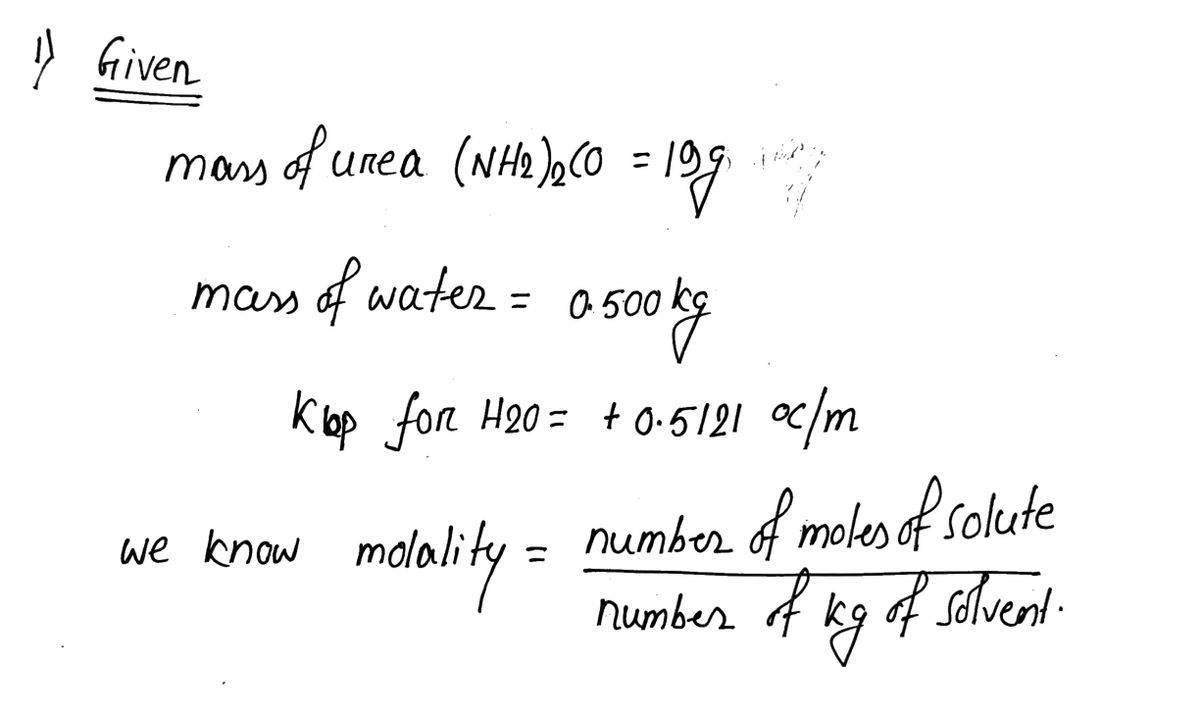What is the boiling point of a solution composed of 19.0 g of urea, (NH₂)2 CO, in 0.500 kg of water? (Kbp for H₂O is +0.5121 °C/m.) Boiling point = °C
What is the boiling point of a solution composed of 19.0 g of urea, (NH₂)2 CO, in 0.500 kg of water? (Kbp for H₂O is +0.5121 °C/m.) Boiling point = °C
Chemistry
10th Edition
ISBN:9781305957404
Author:Steven S. Zumdahl, Susan A. Zumdahl, Donald J. DeCoste
Publisher:Steven S. Zumdahl, Susan A. Zumdahl, Donald J. DeCoste
Chapter1: Chemical Foundations
Section: Chapter Questions
Problem 1RQ: Define and explain the differences between the following terms. a. law and theory b. theory and...
Related questions
Question
![**Problem Statement:**
What is the boiling point of a solution composed of 19.0 g of urea, (NH₂)₂CO, in 0.500 kg of water? (K<sub>bp</sub> for H₂O is +0.5121 °C/m.)
**Solution:**
Boiling point = ☐ °C
---
**Analysis:**
To determine the boiling point of the solution, you need to calculate the molality of the urea in the water and then use the boiling point elevation formula:
1. **Calculate molality (m):**
\[
\text{molality (m)} = \frac{\text{moles of solute}}{\text{kilograms of solvent}}
\]
2. **Determine the moles of urea:**
- Molar mass of urea, (NH₂)₂CO = 60.06 g/mol
- Moles of urea = \(\frac{19.0 \text{ g}}{60.06 \text{ g/mol}}\)
3. **Use the boiling point elevation formula:**
\[
\Delta T_b = i \cdot K_{bp} \cdot \text{molality}
\]
- For non-electrolytes like urea, \(i = 1\).
4. **Calculate the new boiling point:**
- New boiling point = 100°C + ΔT<sub>b</sub> (since the normal boiling point of water is 100°C).
Complete these calculations to find the final boiling point.](/v2/_next/image?url=https%3A%2F%2Fcontent.bartleby.com%2Fqna-images%2Fquestion%2F5e64e050-9cb6-467e-8132-ec94d7497579%2Ff3d37b89-e72f-44c8-91dd-8d6b544c0fd8%2Fyugq7fl_processed.png&w=3840&q=75)
Transcribed Image Text:**Problem Statement:**
What is the boiling point of a solution composed of 19.0 g of urea, (NH₂)₂CO, in 0.500 kg of water? (K<sub>bp</sub> for H₂O is +0.5121 °C/m.)
**Solution:**
Boiling point = ☐ °C
---
**Analysis:**
To determine the boiling point of the solution, you need to calculate the molality of the urea in the water and then use the boiling point elevation formula:
1. **Calculate molality (m):**
\[
\text{molality (m)} = \frac{\text{moles of solute}}{\text{kilograms of solvent}}
\]
2. **Determine the moles of urea:**
- Molar mass of urea, (NH₂)₂CO = 60.06 g/mol
- Moles of urea = \(\frac{19.0 \text{ g}}{60.06 \text{ g/mol}}\)
3. **Use the boiling point elevation formula:**
\[
\Delta T_b = i \cdot K_{bp} \cdot \text{molality}
\]
- For non-electrolytes like urea, \(i = 1\).
4. **Calculate the new boiling point:**
- New boiling point = 100°C + ΔT<sub>b</sub> (since the normal boiling point of water is 100°C).
Complete these calculations to find the final boiling point.
Expert Solution
Step 1

Step by step
Solved in 3 steps with 3 images

Knowledge Booster
Learn more about
Need a deep-dive on the concept behind this application? Look no further. Learn more about this topic, chemistry and related others by exploring similar questions and additional content below.Recommended textbooks for you

Chemistry
Chemistry
ISBN:
9781305957404
Author:
Steven S. Zumdahl, Susan A. Zumdahl, Donald J. DeCoste
Publisher:
Cengage Learning

Chemistry
Chemistry
ISBN:
9781259911156
Author:
Raymond Chang Dr., Jason Overby Professor
Publisher:
McGraw-Hill Education

Principles of Instrumental Analysis
Chemistry
ISBN:
9781305577213
Author:
Douglas A. Skoog, F. James Holler, Stanley R. Crouch
Publisher:
Cengage Learning

Chemistry
Chemistry
ISBN:
9781305957404
Author:
Steven S. Zumdahl, Susan A. Zumdahl, Donald J. DeCoste
Publisher:
Cengage Learning

Chemistry
Chemistry
ISBN:
9781259911156
Author:
Raymond Chang Dr., Jason Overby Professor
Publisher:
McGraw-Hill Education

Principles of Instrumental Analysis
Chemistry
ISBN:
9781305577213
Author:
Douglas A. Skoog, F. James Holler, Stanley R. Crouch
Publisher:
Cengage Learning

Organic Chemistry
Chemistry
ISBN:
9780078021558
Author:
Janice Gorzynski Smith Dr.
Publisher:
McGraw-Hill Education

Chemistry: Principles and Reactions
Chemistry
ISBN:
9781305079373
Author:
William L. Masterton, Cecile N. Hurley
Publisher:
Cengage Learning

Elementary Principles of Chemical Processes, Bind…
Chemistry
ISBN:
9781118431221
Author:
Richard M. Felder, Ronald W. Rousseau, Lisa G. Bullard
Publisher:
WILEY